Personally, I have used everything from a back hoe to scanning electron microscope (SEM) to conduct my research on past ecosystems. I am interested in field-oriented, specimen-based microvertebrate studies in vertebrate biostratigraphy, evolution, and systematics especially the early evolution of dinosaurs as revealed by Triassic-Jurassic paleontology, biostratigraphy and biochronology. Presently I am engaged in multiple Upper Triassic micro- and macrovertebrate projects across North America. A secondary interest involves using scanning electron microscopy (SEM) to investigate microvertebrate taxonomy and evolution throughout the Mesozoic. Some of these projects are described later on this page.
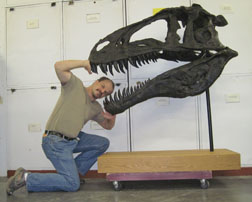
Dissertation: The microvertebrate record of the Upper Triassic (Carnian) lower Chinle Group, southwestern U.S.A. and the early evolution of dinosaurs (465 pp)
Thesis: Litho- and biostratigraphy of the lower Chinle Group, east-central Arizona and west-central New Mexico, with a description of a new theropod (Dinosauria:Theropoda) from the Bluewater Creek Formation (278 pp.)
Some publications available at Academia.edu and NC DOCKS
Publication Highlights
Curriculum Vita
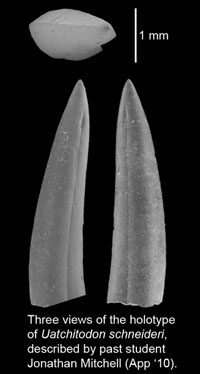
Microvetebrates
Paleontologists generally refer to bones and teeth less than 1 cm (and often less than 1 mm) long as “microvertebrates.” They are extremely important because these small fossils contain the lion’s share of the vertebrate diversity in a paleoecosystem. When I began studying Triassic nonmarine microvertebrates in the 1990s I viewed it as an underpopulated niche—there are plenty of nonmarine microvertebrate studies in the later Mesozoic and throughout the Cenozoic, but few workers collecting these fossil in the Triassic. Thus, my dissertation, published as NMMNH Bulletin 27 remains the most comprehensive treatment of Late Triassic microvertebrates. Ongoing projects involve collaborators with both the NMMNH and the NCSM on microvertebrate fauns from the Triassic of North Carolina, New Mexico, Arizona, and Texas, among others. One aspect of microvertebrate studies is that they are amenable to student research in paleontology, so many undergraduates have helped with all aspects of this research from collecting samples to publishing results.
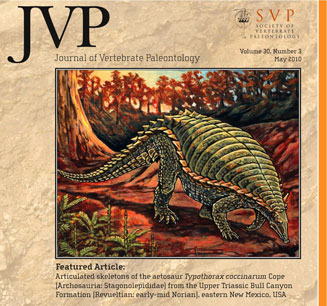
Aetosaurs
My work on aetosaurs began as something of a hobby—a specimen-based research project while I tried to generate collections related to my Master’s thesis. Until the 1990s, aetosaurs were essentially a scientific backwater, with very few publications describing aetosaur fossils in the primary literature, in spite of the fact that they’d been known for ~150 years. Now that has completely changed, with many different parties striving to collect and document these unusual Late Triassic archosaurs. Thanks to much hard work of the staff and volunteers at the NMMNH, I have had the fortune to describe some fantastic aetosaur fossils from Texas and New Mexico, and am now turning my attention to the aetosaurs from North Carolina with collaborators at the NCSM.
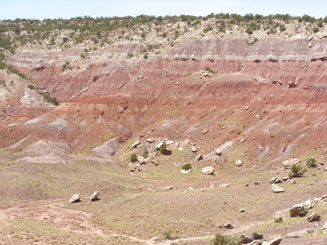
Litho- and biostratigraphy
Because my training is principally geological, I greatly enjoy recording the geologic details associated with vertebrate fossils. My work on lithostratigraphy strives to develop the best possible framework in which to place fossils in the rock record. Similarly, my work in biostratigraphy seeks to provide the best possible estimate for when, geologically speaking, fossil organisms lived. The photograph here shows the Chinle Group strata at Sixmile Canyon, New Mexico. This section, which I measured for my MS thesis in 1994, has turned out to have global significance after I led a trip to sample the basal Blue Member (white band below the purple near the upper part of the photograph). The white sandstone just above the red strata yields detrital zircons which indicate a maximum age of approximately 221 million years ago. http://gsa.confex.com/gsa/2009AM/finalprogram/abstract_162342.htm
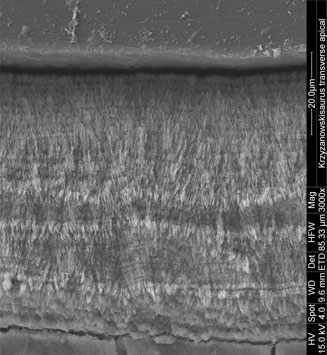
Tooth enamel microstructure
As a byproduct of my SEM use, I have dabbled in understanding the microstructure of the teeth of archosauriform reptiles. Existing studies have focused primarily on younger, more derived animals (e.g., Jurassic and Cretaceous dinosaurs and crocodilians), so I feel there is a real opportunity to evaluate aspects of the basal radiation of archosauriforms in the Triassic through the microstructure of their teeth.
SEM micrograph of the tooth enamel microstructure of a maxillary/dentary tooth of the enigmatic archosauriform Krzyzanowskisaurus hunti. (right)
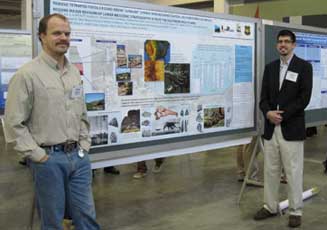
Students and my research
Numerous students have worked with me on projects, predating my career at Appalachian by many years. Appalachian students are involved in most of the projects I showcase here, and many get their first research experience presenting not just at Appalachian’s student research day, but at major meetings like the Society of Vertebrate Paleontology and Geological Society of America meetings. Appalachian (or other) students interested in research projects should contact me directly.

